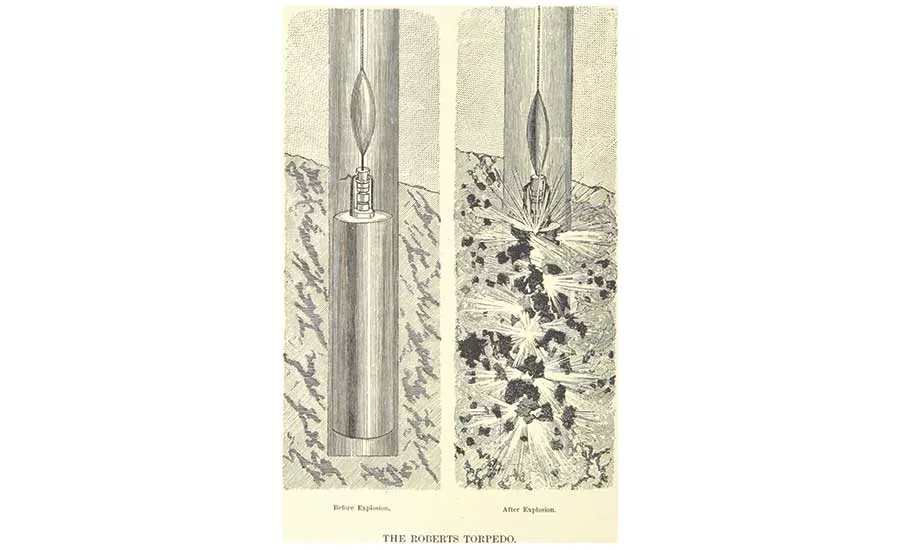For Drilling Products, It’s a History of Innovation

The “Roberts Torpedo” revolutionized oil well production in the 1860s. Source: Wikimedia Commons
I want to take a moment to look back, because it’s both instructive and inspiring.
Here at National Driller, we’re taking a dive into drilling history for a project we’ll unveil soon. Let me say first that history fascinates me. I’ve dug into genealogy and subscribe to several podcasts that take deep, narrative looks at historical events. But I hadn’t spent much time thinking about the history of drilling. It’s littered with brave, and perhaps a bit nutty, people. That nuttiness, however, is what gave these folks the vision to create the equipment and techniques that now get taken for granted. I want to spotlight a couple of those people.
It’s Torpedo Time
In the mid-1860s, Civil War vet Colonel E.A.L. Roberts commercialized the “Roberts Torpedo.” This shooting-the-well process was the beta version of modern hydraulic fracturing. Roberts was a dentist by training and actually quite well known for making artificial teeth. Obviously, he had a mind for detail and tinkering.
Drillers had already figured out that explosives could spur oil well production. Roberts, however, polished and patented the idea. His torpedo was a canister the size of a Thermos filled with gunpowder and topped with a blasting cap. Drillers lowered the torpedo into a lagging oil well to the oil-bearing zone, then topped off the well with water. They would then drop a weight onto the blasting cap to detonate it, and the water would force the blast out into the formation. The torpedo’s first successful deployment was near Titusville, Pa., on Jan. 21, 1865.
This process proved both clever and effective. Roberts built a company around the idea, charging people for the torpedoes themselves and taking a percentage cut of any increased production. I’m sure it made him a bunch of money, but he had trouble defending his patent from copycats.
Let’s Get Portable
The other innovative figure I want to highlight is a name familiar to all of my readers: George E. Failing. In 1930, Failing was at a dark point — like a lot of Americans during the Depression. He made a bundle servicing cable tools and rotary rigs. But, when the bottom fell out of the economy in 1929, bankers called in his loans and his supply company collapsed. With more time to tinker, he had an idea.
Steam-powered rotary rigs did a lot of the drilling in the 1920s. Their big limitation? While they were portable, setting them up on a hole took a week. Then, of course, they had to be broken down again to go to the next hole. Failing’s answer? What if I took a rotary rig, stuck it on my old Ford and added an assembly to power the drilling from the engine instead of steam? The first portable rotary rig was born. Failing’s new truck-mounted rig could mobilize much quicker, drilling 10 holes in a day. Suddenly, spending a week mobilizing a “portable” steam-powered rig seemed quaint and outdated.
Drillers know the rest of the story. Failing built a huge company (with an assist from WWII), eventually selling in 1953. That company has changed hand a few times, but each new owner has been careful to keep the name (even if it’s shortened now to Gefco).
What Innovation Changed the Way You Work?
Drilling history is full of folks who tinkered their way into new products and methods. What drilling innovation most influenced the way you work? Why? Was it coring bits? The tri-cone? Split spoons? Tell us. Send an email to verduscoj@bnpmedia.com.
Stay safe out there, drillers.
Looking for a reprint of this article?
From high-res PDFs to custom plaques, order your copy today!



